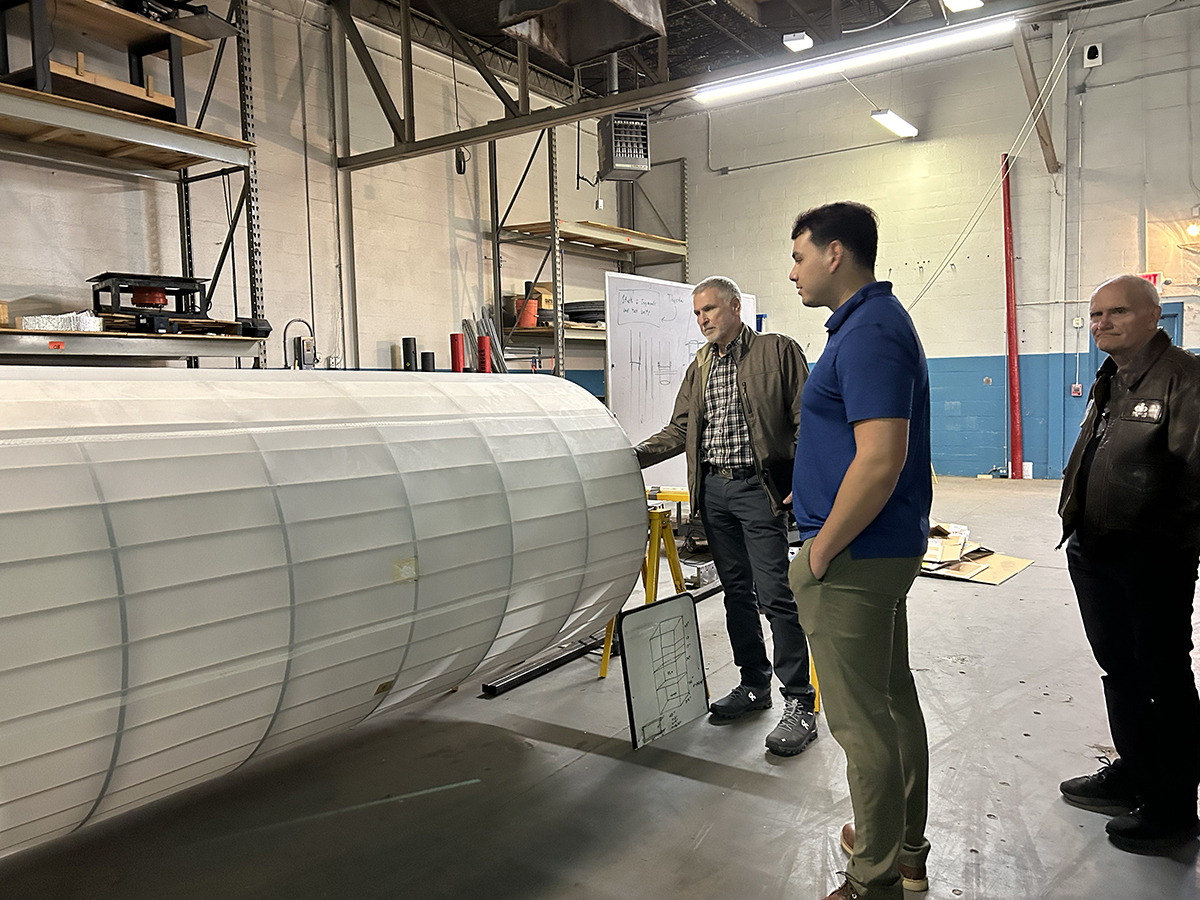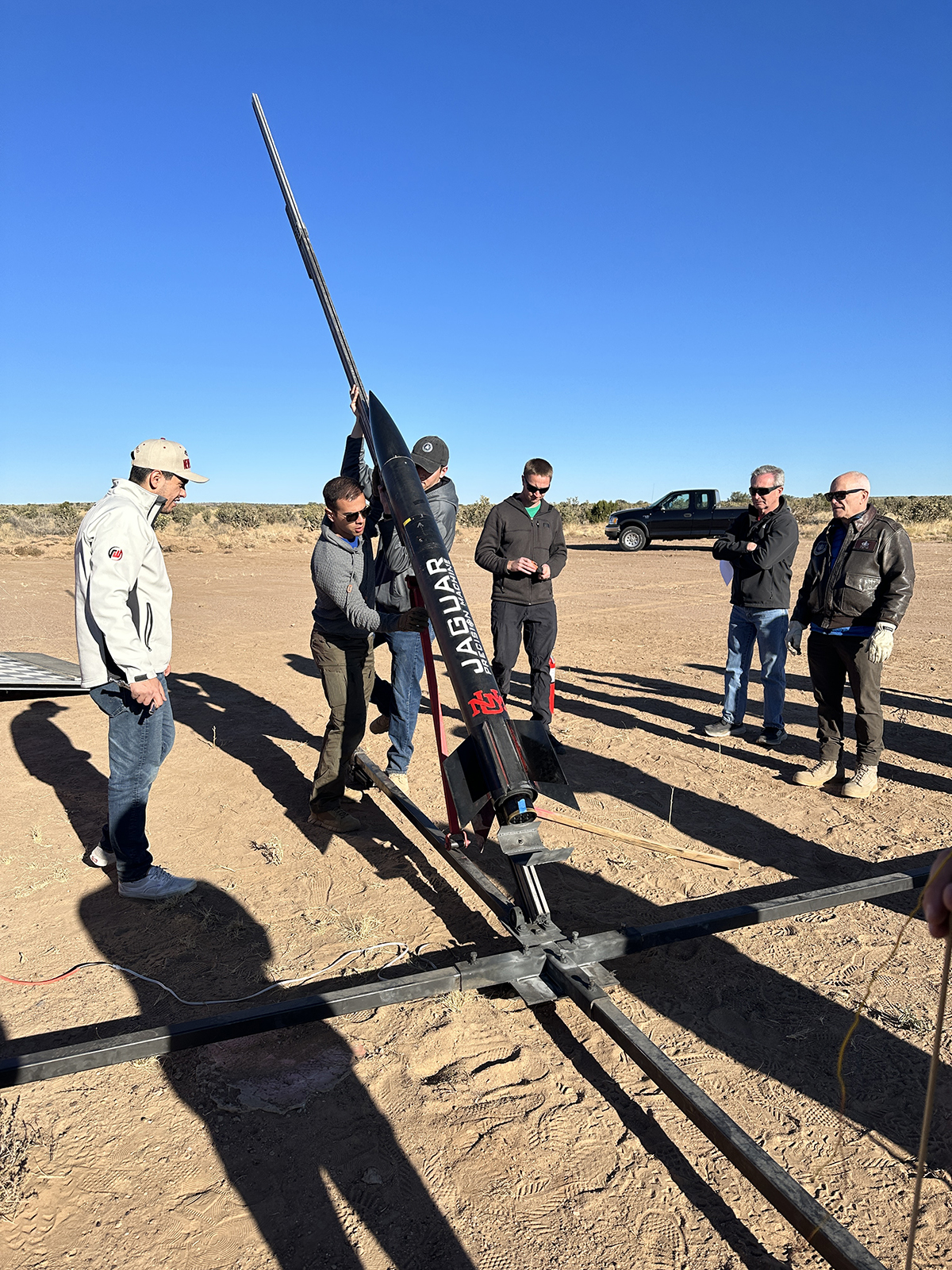Recent News
As LOBOMotorsports director plans retirement, $1 million endowment ensures his legacy will continue
October 30, 2025
College advisor uses Girl Scout leadership experience to design new NSO activities
October 6, 2025
Ph.D. student receives grant to present at MECC 2025
August 22, 2025
Shen reflects on 9 years as mechanical engineering chair
August 19, 2025
News Archives
UNM’s Lobo Launch team on an upward trajectory with three rocket projects
February 13, 2024 - by Kim Delker

Bret Simpkins, a supporter of the Lobo Launch program and an alumnus of the Department of Nuclear Engineering, inspects one of the rockets with Christopher Solis and Doc Aguilar at their build space near campus.
For 22 seniors in mechanical engineering this year, their capstone design project is literally rocket science — and they wouldn’t have it any other way.
After enduring a dip in enrollment last year in a post-pandemic higher education landscape, The University of New Mexico Lobo Launch team — where soon-to-be graduates fulfill their senior design requirement designing and building a rocket — is back in full force.
UNM’s team is led by Fernando “Doc” Aguilar, a retired U.S. Air Force colonel with over 30 years of experience in space launch. There is technically a cap of 20 students for the two-semester program. But the program has become so popular — and labor-intensive this year with additional projects — he authorized two extra students to enroll in the classes.
Lobo Launch begins in the fall semester, where students learn about the fundamentals of practical rocket design and theory. During this time, they begin their rocket design with the use of several simulation and design software programs as well as formulate a rocket build materials list. Fall semester culminates with a preliminary design review in front of a panel of engineers from industry. Then in the spring, this is followed by a critical design review before the students put their learned skills to the test and begin in earnest fabricating and testing their rockets for each program.
Aguilar said that Lobo Launch currently consists of three distinct rocket programs, each managed by seven students, one being the overall program manager. Each team has plenty to keep them busy.

The most longstanding program is the Spaceport America Cup. It is an international, intercollegiate sounding rocket competition held every summer at Spaceport America near Las Cruces. UNM will once again compete in the Spaceport America Cup, which this year will be held June 17-22. It features more than 150 teams from 24 countries. UNM has been competing in the Spaceport America Cup since 2019 and has generally placed in the top 10, with third place being their best showing.
For this intercollegiate rocket contest, each team is required to design, build and launch a rocket that will lift a payload of no less than 8.8 pounds (4 kilograms) to 10,000 feet. This year’s competition rocket is designed to reach this altitude while remaining subsonic (720 miles per hour) for more accurate modeling.
The competition rocket is lean and mean — a small rocket with a big motor. Although the team can build on past year’s designs, the rocket must be an entirely new vehicle, not one recycled from a prior class. The rocket is 10 feet long and features six fins.
Aguilar explained the decision to have six fins: “This aspect increases drag and precludes adding ballast to ensure the rocket does not surpass 10,000 feet.”
For the Spaceport America Cup, the rocket will be evaluated in several areas, one of which is how closely the rocket reaches the target apogee of 10,000 feet (points are deducted for how much under or over the rocket reaches). The team is also judged on the quality of their project documentation, a poster session, the quality of their system’s overall design and construction, as well as the program’s overall operational efficiency and performance demonstrated at the competition. The rocket also must be recoverable and ready to relaunch immediately. And to increase the competition score, the rocket will also house an active experiment in the payload bay.
Months of designing and a few flight tests culminate in the competition, where the team has one shot to launch. Conditioned from a 30-year career in the space launch arena, Aguilar said he is always “antsy” about missing a launch window. He emphasizes the importance to the team to be the first launch of the competition.
“This earns the UNM team an additional 200 points and reduces the chance of being rained out or scrubbed by high winds,” he said.
A newer Lobo Launch program is the Los Alamos Experiment Lift program. It supports Los Alamos National Laboratory (LANL) in launching LANL experiments and developmental subsystems. The LANL requirements stipulate a rocket that can provide five Gs of acceleration for 5 seconds. The rocket must also accommodate a 10-pound payload that is 8 inches in diameter and 16 inches long then propel it to 10,000 feet altitude. The students this year have designed a two-stage rocket that will far surpass the LANL requirements by reaching an altitude of nearly 60,000 feet.
The third Lobo Launch project is the so-called BFLR — Big Fat Lobo Rocket. This rocket sports a 50-foot- long rocket body that is 4 feet in diameter.
“This is an aerospace exercise in an exceptionally large air frame that is very light and strong known as ‘semi-monocoque,’ ” Aguilar said. This project tests the students’ skills on a completely different level.
He said that a previous similarly-scoped rocket failed due to excessively large fins that sheared off in flight. It was a scaled replica of a vintage ICBM (intercontinental ballistic missile) that demanded large fins.
Aguilar said the current BFLR is not a replica of any legacy rocket.
“It is purposely designed for expediency and thus has six small robust fins versus four fins that would be long and fragile,” he said.
These projects are a lot to manage. So, to keep the teams on track, Aguilar has implemented the same type of program management protocols as found in industry: Milestones, Gantt charts, preliminary design reviews (PDRs) and critical design reviews (CDRs).
“The students follow the program management process as is used in the real world,” he said.
This includes weekly “point meetings,” where the teams update the “client” (played by Aguilar) on their status in the design, fabrication and testing stages. The team reports status in terms of building the rocket, any issues they are encountering and where their budget stands, and all details are included in Gantt charts. Additionally, the students must field any questions posed by their client-teacher, as well as special industry guests that sometimes attend.
“Your outcome will be based on how methodical and organized you are,” Aguilar said.
Christopher Solis, who is the overall manager for all three projects in Lobo Launch this semester, said he finds the real-life approach to project management to be useful for both the current rocket projects as well as his future career in the aerospace industry.
“The biggest challenge is keeping everything organized and documented,” he said. “It’s been useful to realize that we have to treat this as an actual contract.”
For the last four years, Solis has been an intern with Redwire Space. After graduation, he is planning to continue working there, as well as enrolling in the Space Systems Engineering online master’s program at UNM.
Aguilar said that the Lobo Launch program is demanding, but students put in time and effort to see a real payoff at the end.
“Our students are super motivated, and I’m pleased with them,” he said. “I don’t think I’ve had a class where all of my students didn’t have job offers before they graduate.”
The Lobo Launch team is supported almost entirely from donations. Support the team via the UNM Foundation.
